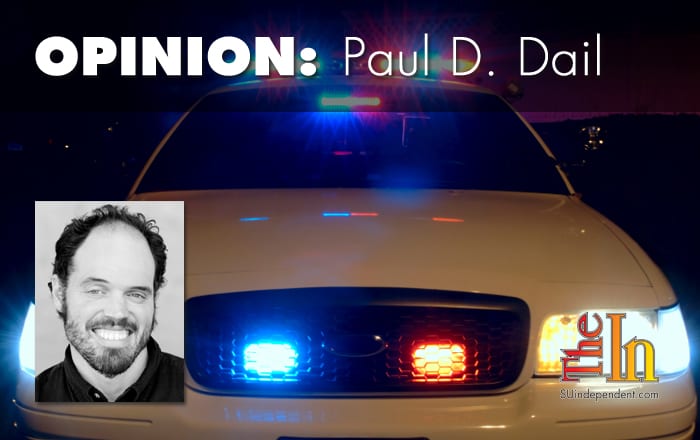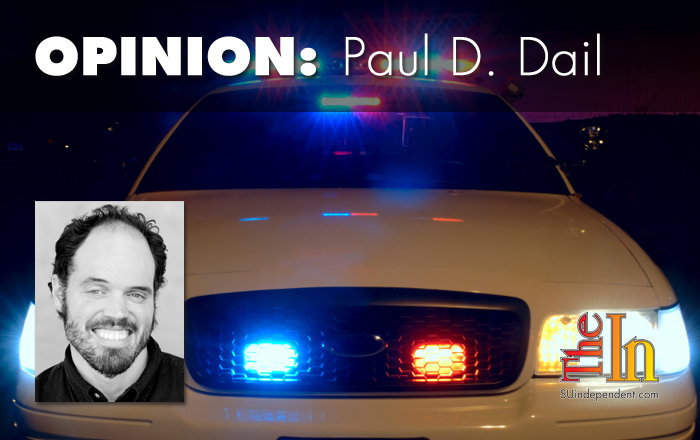With the Parowan incident, I’m wary of the ‘just another cop shooting’ bandwagon
 |
| Image: Scott Davidson |
Written by Paul Dail
Last Saturday night, my wife and I were watching an episode of “Justified,” a show about a U.S. Marshal living in the present day but who has definite traces of an Old West lawman. This officer of the law has a tendency to get himself in trouble for regularly using deadly force.
Earlier that day, I had read Tracie Sullivan’s report of the officer-involved Parowan police shooting that ended in the death of Rocco “Rocky” Palmisano. And as I watched U.S. Marshal Raylan Givens gunning down the bad guys, I was nudged out of my normal numb Hollywood desensitization to such violence. Even though “Justified” is a fictional depiction, these were actual human beings he was killing.
So in this sense, I appreciate Tracie Sullivan’s coverage. While some other media outlets sensationalized this story at the outset, Tracie provided the very human side to officer-involved shootings, which have further-reaching consequences beyond the evening news. Many people can be traumatized by these events, even once the cameras and recorders are off. I have the utmost sympathy for Palmisano’s son and wife who had to witness him die.
However, having read several of the comments in response to her article, I’m having a hard time joining with those who are calling this a travesty, and I’m certainly not going to jump on the bandwagon of calling this another example of the police killing an innocent man. There’s a lot of bad stuff going on out there involving law enforcement and misuse of power, but you can’t canonize every person who gets shot by a police officer in the line of duty. Some of them are bad people doing bad things, regardless of whether they have people who will miss them if they’re gone.
To get back to “Justified,” it’s easier to accept when we see the bad guys get shot on television and in movies because, well, for starters, we don’t know their backstories. Does that hired gun for the drug cartel have a wife and kids and neighbors who would say nice things about them? Maybe so. But beyond that, if he’s out trying to kill someone, we get back to the whole inherent “bad guy” thing.
There are some questions people have brought up in comments regarding the Parowan incident which the police haven’t answered yet. Did the rookie officer announce his presence? Did he show up at the scene with his lights flashing? Had Palmisano merely been drinking or was he intoxicated?
But that last question is where the line starts getting fuzzy and we start getting into what would seem to be indisputable and damning facts. He was drinking. No one denies that. And brandishing a firearm for some reason. Around a police officer and his son, a twelve-year-old at whom—at the very least—the elder Palmisano had been yelling and swearing.
Without an official report, I won’t automatically go along with the witness statement that the father had been beating the son; however, for a family member to say “If Rocky was beating him … why didn’t he have any bruises?”—as opposed to, say, something along the lines of, “He never laid a finger on his son”—sounds an awful lot like, “The boy just fell down some stairs. He’s so clumsy.”
If it were still the Old West—a time when I might’ve been armed even if I wasn’t a lawman—under similar circumstances, I probably would’ve shot Palmisano too. Not to kill, but at least to put him down.
But the fact is, Uresk was a lawman. While some questions remain unanswered, when you get back to those facts released by the Cedar City Police Department, those that I mentioned above and those more recently released that said Palmisano actually raised the gun and advanced toward Officer Uresk, you get a case of the shooting being justified in my opinion.
And while it’s unclear from the reports exactly where on his body Palmisano was shot, he didn’t die until after paramedics had shown up, so unlike U.S. Marshal Raylan Givens shootin’ ‘em all dead on the spot, it wouldn’t appear that Uresk was aiming to kill. But since I don’t know for sure, I’ll give Uresk the benefit of the doubt and say that he was just doing what he was trained to do: subduing a threat.
A man who had been drinking and shouting at his son and brandishing a firearm in the presence of a police officer.
Once the media (and in this day and age, I will include the “social media”) picks up on a line, suddenly it becomes a case of “every time a police officer shoots somebody, it’s an abuse of power.” Honestly, I’m not one hundred percent sure why this bothers me so much. In my younger years, I was pretty heavily anti-establishment and mistrustful of most authority, especially law enforcement.
The younger me would’ve been offended to hear the older me suggest that Officer Uresk wasn’t in the wrong that night. I guess these days I’ve come to terms with some realities. We live in a country where we have made certain decisions regarding law enforcement officials and their ability to carry out their duties to protect and serve the public. For better or for worse, we have given firearms to them for use in an official capacity.
It’s true that sometimes this tremendous power and authority to use said firearms has been misused to horrible aftermaths, with police officers shooting unarmed—and sometimes even completely innocent—people. For these actions, those law enforcement officials should be held accountable. They cannot be given carte blanche. Each situation must be examined individually to determine if it’s a case of an abuse or misuse of power. While I will admit that there are still questions that remain unanswered, if Officer Uresk followed protocol upon approach of the Palmisano residence, I don’t believe this is one of those cases.
Paul D. Dail is a freelance writer and managing editor of The Independent. He received his BFA in English with a creative writing emphasis from the University of Montana, Missoula. In addition to his contributions to The Independent, he also enjoys writing both creative nonfiction and fiction (with a penchant for the darker side of the page). His collection of flash fiction, “Free Five,” has spent over a year and a half in the top 50 Kindle Horror Short Stories since its publication in 2012.
Currently, Paul lives on the outskirts of Kanarraville, surrounded by the sagebrush and pinyon junipers, with his wife and two children. Read more about him at www.pauldail.com. While he prefers that any comments directed at a specific article be posted in a public forum, he welcomes all other correspondence at [email protected].




